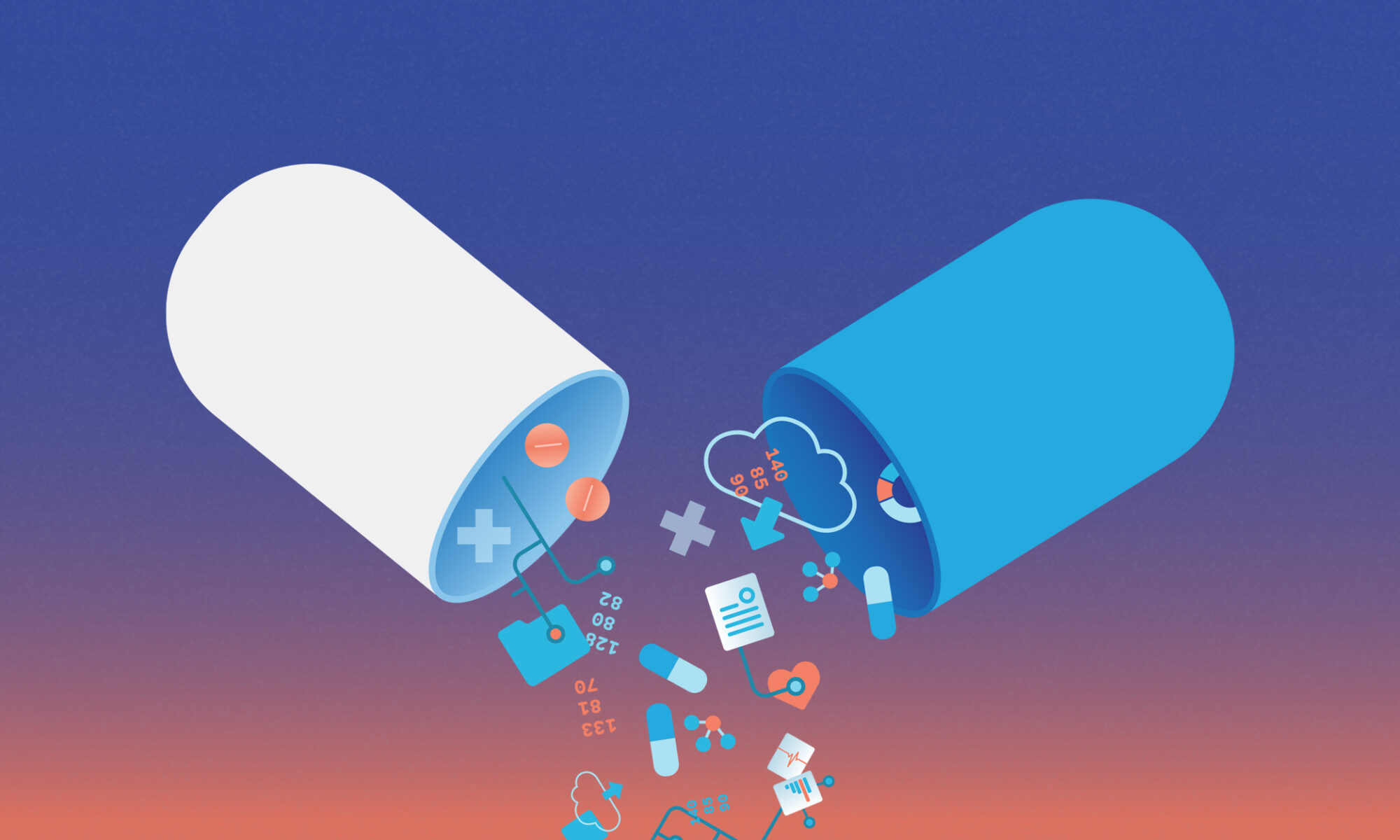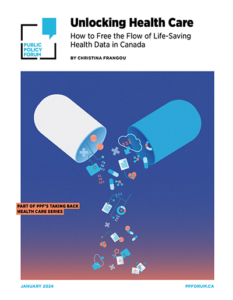
Unlocking Health Care: How to free the flow of life-saving health data in Canada

Introduction
In early 2023, the Public Policy Forum’s Taking Back Health Care project set out to address shortcomings in Canada’s precious health-care system. With our expert panel,[1] in the first report, Taking Back Health Care, we identified bold but achievable changes to realize the vision of accessible, timely and high-quality services. The necessary reforms, we asserted in our second report, Primary Care for Everyone, can’t be delayed. Improving the system is not merely the function of more spending, but of seizing new opportunities to do things better in the digital age.
The first two reports argued that access to primary-care givers should be as routine as a child’s admission to kindergarten. We called for a 30-minute standard, with governments and health providers moving toward the goal of everyone in Canada being able to access a publicly funded primary-care team within a half-hour radius of where they live or work.
For this, our third report in the Taking Back Health Care series, PPF’s expert panel focuses on some of the key fundamentals in a modern, human-centred health system: data and digitization. This time, we ask why the information that increasingly determines the health and wellness of Canadians should not be as readily available to them as banking or census data. We question why this data can’t flow smoothly and securely within a pre-approved digital network of health providers revolving around users of the system. In so doing, we are sounding the alarm about Canada’s chronic, subpar performance on data, the vital currency of a digital-age system. The bottom line is simple: better health outcomes can be achieved with greater efficiency at lower cost to Canadians.
Think of digital technology as the vehicle and data as the fuel. They are the engines of 21st-century progress, permeating every facet of our lives. This is particularly true in the realm of health, where the convergence of data and digital advancement hold immense potential to transform the way we experience, understand, deliver and improve care. By harnessing the power of data analytics, artificial intelligence and digital technologies, health systems can unlock and take full advantage of valuable insights into the health and wellness of people and how the system is performing for them. It can enhance diagnostic accuracy, optimize treatment plans, revolutionize preventative regimens, and drive innovation. By organizing data and facilitating access to it, we can support individuals and communities to better understand, engage in and manage their own health journeys.
The problem is not that decent data does not exist; the bigger issue is that it is not sufficiently connected, accessible or user friendly. The pieces of countless medical puzzles remain mixed up in the box — too often a black box of paper notes and walled-off information. In the immediate term, this condemns patients, family advocates and clinicians to partially informed decisions and administrators to poor allocation of scarce resources. Without good data to make the health-care rounds, referrals become cumbersome, diagnoses slow and unsafe treatments all too common. Data shortcomings are contributing to the burnout of health-care workers. Too many of them flee the system — in frustration at the time wasted in hunting down patient information and in distress at having to provide care in the absence of vital information. Without good data, policymakers, patients and providers are left to engage in an uncomfortable degree of guesswork.
The transformative potential of health-care data is staggering. Imagine: more convenient access to health services; reduced wait times; more personalized care; identification of health risks and proactive intervention enabled by predictive analytics and AI-driven tools; and seamless access to electronic health records through user-friendly portals and apps. Creating frictionless health-information platforms across providers can reduce errors and the waste inherent in unco-ordinated care. Access to reliable health information and educational resources can empower overwhelmed patients to exercise informed agency over tough decisions with the support of family, health providers, community agencies, municipalities and support groups. It will also drive more efficient management over wait times, help address burnout, and reduce instances of hallway medicine. Mobile apps, digital tools and wearables can offer real-time health tips, medication reminders and continuous self-monitoring of health and well-being.
Canada is lagging behind. This is frustrating but it does provide the consolation prize of second-mover advantage. In catching up with high-performing countries on basic data infrastructure (the pipes), we can apply their lessons learned to leapfrog into the top ranks of what flows through those pipes (health information). To be clear, we are talking about much more than digitized health records, which would have constituted an achievement two decades ago but lacks ambition today. The vision is of dynamic, digital networks of information that enable our currently troubled health-care system to spring from the middle to the front of the pack.
The resulting changes will usher in a new health-care era that embraces the enduring principles of our public system — universality, comprehensiveness, accessibility, portability and public administration — through a modern health-care lens. Rather than being about sickness, it is about both care and wellness. It is proactive rather than reactive; integrated and continuous rather than siloed and episodic. And rather than being one-treatment-fits-all, it is about individualized wellness and precision treatments. All this renders it more effective and equitable at the same time.
This is not a nice to have — it is a must have. It will spell the difference between people exercising agency over their health choices or being passive recipients of fate and circumstance.
Without such a leapfrog strategy, we tacitly accept what we would all agree is unacceptable: a suboptimal system in which users are denied the right to co-manage their own wellness and providers are denied the tools to intervene efficiently and effectively on behalf of those they serve. As things stand, Canadians are deeply disappointed by a health-care system they once cherished as a key component of their national identity.
Nova Scotia’s Office of Regulatory Affairs and Service Effectiveness, in partnership with Doctors Nova Scotia, led a project in 2020 to better understand the impact of physician administrative burden. The Canadian Federation of Independent Business undertook further analysis and showed the extent to which navigating patient paper records hinders doctors’ ability to provide basic care. The Patients Before Paperwork report found that Canadian physicians lose 18.5 million hours a year to unnecessary administrative work — the equivalent of 55.6 million patient visits.[2] To reduce doctor fatigue and burnout, the Nova Scotia government has committed to reducing red tape for physicians, an initiative that aims to reduce unnecessary administrative work by 400,000 hours a year — the equivalent of 1.2 million patient visits — by the end of 2024.[3]
A giant leap forward into a nationally connected, data-enabled, human-centred system is the way to re-instill pride in Canadian health care. The Public Policy Forum is far from the first to recognize this problem. By our count, there have been at least 32 reports in the past five years totalling more than 335 pages. They cover everything from elder care to interprovincial data usage to primary care. That we need to point yet again to the solutions is a problem.
Whether or not one wholly agrees, a recent British Medical Journal editorial about Canada’s management of COVID-19 is worth noting: “The picture that emerges is an ill-prepared country with out-dated data systems, poor coordination and cohesion, and blindness about its citizens’ diverse needs.”[4]
In the following pages, we show what a high-functioning, data- and digital-rich system looks like and how it can be used by Canadians and for the benefit of Canadians. We introduce you to Alan Dore of Hamilton, Mohamed Alarakhia of Waterloo, Greg Price of Acme, Alberta, and Heather Campbell of Calgary, whose personal stories underscore the consequences of data inadequacies. We also take you to Israel and Alaska to see how contemporary data arrangements are delivering the goods.
The main message of this report is that we can do better. We must do better. Here is how.
Good Data, Better Health Solutions
Smart collection and use of data has led to personalized medicines for cancer, enabled treatments for rare diseases, and identified hazards that cause people in communities to fall sick. Good data leads to better outcomes.
Canada lags behind peer countries in adopting data and digital technologies in the health space. In France, the state functions as a regulator and accelerator of the country’s fully insured digital health-care system, enforcing high ethical standards for patient care and fostering technology use (including artificial intelligence) aimed at creating a leading digital health-care market.[5] Israel makes use of its large technological potential to invest in nationwide digital health-care coverage with an emphasis on promoting advanced and sustainable digital health tools and adopting newer technology-based systems such as virtual care services and AI-supported diagnosis and treatment.[6] As these technologies become the norm in advanced countries, their utility in Canada is constrained by outdated and scattershot health-record keeping systems, with life and death consequences.
In health care, good data starts with the creation of digital health records, which in turn enable data to be used to improve health care. Electronic records are the cornerstone of any credible human-centred health system. Yet, incredibly, they are neither standard nor standardized across Canada. Where they exist, they are often static and unavailable to anyone outside a specific health discipline, institution or location. This assumes a person will receive a lifetime of care in the exact same place, with the exact same provider. Although electronic health records have been around in one form or another since the mid-1960s,[7] these records (not including Quebec, Prince Edward Island or the territories) still cover just 37 percent of Canadians.[8] A resounding 92 percent of health-care workers say that having digital health records available, no matter where a patient seeks care, would increase patient safety and quality of care.[9]
The objective of a single record is further complicated in Canada by our highly decentralized federation. Even where digital records exist, they don’t cross provincial boundaries. When it comes to Israel, since 2016, every patient in the country has had a single electronic medical record accessible by health-care providers at all health institutions. That includes public and private hospitals, primary-care clinics, imaging centres and military facilities. “In health care, an integrated electronic medical record is critical to knowing what has happened to your patient,” says Dr. Eyal Zimlichman, Chief Transformation Officer and Chief Innovation Officer at Sheba Medical Center in Tel Aviv, Israel. He added that only two percent chose that approach initially.
He views electronic records as the foundation of a well-functioning health system, calling them the “operating system” of the hospital. From this base, additional technologies can be layered on. In the pandemic, the availability of comprehensive anonymized information persuaded pharmaceutical companies wanting a quick read on adverse effects to make Israel one of the first countries to receive vaccines.
Given its electronic record-keeping, Sheba is an early mover in using artificial intelligence to assist physicians in clinical decision-making. It now has a database of more than one million CT scans taken over many years. When physicians make an assessment based on a CT image, the AI system also offers an analysis. When care providers disagree with the AI — termed a “decision support” system to emphasize that it supports rather than dictates to them — they will often seek a second opinion from colleagues. AI is also being employed to read the pathology slides, a process that takes “milliseconds and gives us insights, for example, as to which therapy for cancer this patient would react to,” Dr. Zimlichman says.
He anticipates AI-driven changes will move at breathtaking speed, from diagnostics to simple medical appointments. Soon, AI tools could summarize the patient-doctor appointment, including writing follow-up notes and scheduling appointments, reducing the administrative burden on staff. This could also allow for more human contact as health-care workers focus their attention on the patient instead of splitting their focus between patient and computer.
As for the sensitive issue of privacy, the system attempts to allay any concerns by using ultra-secure formats to share data. “We’ve moved to a level of confidence where physicians trust the technology more and more,” Dr. Zimlichman says. “And this is what we’re going to be seeing in the future.” The lesson: public and professional confidence in the integrity of the system is integral to putting it to work for people.
According to the World Health Organization, Israel’s system will next focus on “digital prescriptions, automatic approval of reimbursement for ambulatory treatments, and digitalized patient-caregiver communication and home monitoring.”[10]
“We’re at a turning point,” Dr. Zimlichman says.
Alaska: A True and Informed Health Partnership
During the pandemic, an innovative, Indigenous-owned health-care organization in Alaska had an audacious idea.
Leaders in the Southcentral Foundation’s Nuka System of Care decided to direct some of its COVID funding to purchase 6,000 Apple watches, Garmin Fitbits, and blood pressure cuffs to help lay the groundwork for reimagined care spanning far beyond the pandemic. The devices were distributed for free among Nuka’s customer-owners (the term the non-profit uses to describe its patients). A person just had to want one and promise to use it.
Once customer-owners start wearing the devices, their health data — information such as heart rate and blood pressure — is downloaded automatically onto the patient portal of the organization’s care app. Health-care providers, with consent, can sign in and track what is happening to a patient in real time, as can the customer-owner.
Here’s how it works. A person who feels dizzy in the middle of the night might call their doctor the next morning. They’ll be asked to check their watch to find both their current heart rate and the 3 a.m. reading.
“Let’s say your blood pressure was terribly low at 3 a.m. because you were sleeping and very relaxed, and I had put you on a blood-pressure medication several months ago to accommodate the blood pressure you had when I saw you in the office,” says Steve Tierney, Nuka’s medical director of quality improvement and chief medical informatics officer.
“But apparently that’s too low for you at 3 a.m., so how about we reduce that. I would say we cut this dose of Cinapril from 20 mg to 10 mg. I want you to take your blood pressure every couple of days for three weeks and let’s see what it’s doing.
“We can just start fixing what needs to be fixed,” Tierney adds, noting the data is used simply as a screening tool; diagnostic-level devices still require office visits. However, scientific studies are already proving that data collected through the day via wearables is richer than the snapshots taken during visits to health-care facilities.[11] They also empower individuals to participate more fully in the process of diagnosis, behaviour change and self-monitoring.
Health data is much more than the history your physician takes or is in your hospital charts. In our connected world, it also draws on personal technologies such as smartwatches, glucose monitors and pacemakers. Apple watches, Fitbits and other wearables can detect slight changes that provide early indications of a health problem. They help people manage chronic diseases by tracking indictors like blood sugar or food intake. They give quantifiable information on how the wearer is sleeping and how much they are exercising. This data can both lengthen lives and improve the quality of those lives.
An estimated 14 percent of Canadians use Internet-connected wearable smart devices.[12] Such tools have the potential to revolutionize the way health care is conceived and managed. It is a two-way street, alerting health professionals to significant changes between patient visits while also uploading multiple streams of information from doctors’ offices and hospitals into our everyday lives. When included in formal health records — again, with the user’s permission — this data can provide a treasure trove of clues that inform individual behaviour and enable health providers to proactively ward off risks or treat illness more quickly and less intrusively.
For Nuka, the adoption of wearable technologies is part of the solution to a question that has driven the organization since its launch more than two decades ago: how can a health system provide reliable medical care, foster good patient-provider relationships, and improve the well-being of its population — all without breaking the bank?
The answer lies in shared decision-making between health providers and the people being served by the health system. In 1996, Nuka was established to provide health care to more than 65,000 Alaska Native and American Indian people, based on Indigenous cultural values. The people of the region, who became the owners of the new health system, said: “We want to be healthier. We do not want to have to repeat our stories. We want to have a relationship with our provider,” recalls Tierney, who was there at the beginning as a primary-care physician.
As part of this simple revolution, every customer-owner enjoys full access to their health data through the Nuka care app. Each customer-owner has a private account that merges their health-system generated data (such as lab test results and vaccine records), medical notes from appointments with care providers, and self-generated data (such as hours of sleep or glucose counts). Doctors and patients can track changes in real time.
“Wearables are the next step in a long story about how we philosophically approach the process of medicine, which should be about one person who needs help asking another person who’s trained to provide that help. That’s all it is,” says Tierney.
“This way, each person is a fully engaged partner in the process of improving their health.”
Canadian health care could use more of such audacity.
Hamilton: Bringing the Hospital Home
Just before Christmas 2022, Alan Dore had open coronary artery bypass surgery at Hamilton General Hospital.
It was a stressful time for the former city administrator. He’d had a stroke several months earlier, which affected his ability to speak, followed by COVID. Now, in the hospital, he couldn’t get to sleep — the beeps and the bustling kept him awake. His wife spent her days by his side, helping him communicate with the staff.
After 12 days, Dore was discharged from hospital, accompanied by technology that allowed nurses to keep by-the-minute tabs on his recovery.
Dore did not go home in the traditional way, left to fend for himself at a vulnerable and unfamiliar time. Instead, he went home to a virtual ward. Nurses continuously followed his progress through data collected from a Bluetooth-enabled tablet, blood-pressure monitor, and cardiac monitor at Dore’s home. Once a day, he checked in by phone with a nurse. For Dore, the data helped supplement the information that he sometimes struggled to express in words.
Five days after his discharge, a sensor tracking Dore’s heart rate triggered an alarm in the monitoring station several kilometres away at the hospital. A nurse called immediately and, after asking some questions, adjusted his medications. When he developed gastrointestinal issues later that week, nurses asked him to come in. With his data already available to the care team, Dore could bypass the emergency department and head straight to a clinic designated for post-operative patients. After a consultation with a doctor on duty, he returned home to his virtual ward — now with temporary home-care support — sparing him another expensive hospital stay.
Dore has since gone on to a full recovery. He credits the program with getting him home sooner and safer, where he could convalesce alongside his wife and dog, and enjoy home-cooked meals and his own bed. “It’s fascinating to me that they could do this,” he says, a satisfied customer.
The use of digital monitoring devices is beginning to produce encouraging results. For example, the program at Hamilton General Hospital cuts two days on average off a patient’s hospital stay after surgery and reduces readmission rates by 40 percent. Randomized, controlled trials — the highest level of evidence — have even shown that continuous remote monitoring is associated with a survival benefit in patients with heart failure. Its adoption in Canada, though, remains stubbornly slow. Only one in four physicians here reports using remote monitoring or connected devices, even as evidence shows patients with monitors are less likely to be readmitted to hospital, suffer through unrelieved pain, or experience uncorrected prescription drug errors. A bonus: the burden on emergency rooms and hospital staff is lessened.
These monitoring technologies allow patients to receive safe, high-quality care at home or in their community. They have the double benefit of freeing up hospital beds for people who need them most and enabling patients from rural and remote parts of the country, including Indigenous communities, to recover amid their loved ones.
The U.K.’s National Health Service is the world leader in virtual wards, offering patients hospital-level care at home where they often recover more comfortably. Case studies carried out by the Access Group on the NHS virtual wards found that the Heart Failure Virtual Hospital, a specialized virtual ward designed to prevent readmission, demonstrated an 11 percent reduction in readmission rates compared to regular hospitals.[13]
Since its inception in 2022, the NHS’s virtual ward program has grown quickly.[14] More than 160,000 adults across the United Kingdom have been cared for on virtual wards by multidisciplinary teams using a combination of remote monitoring and at-home visits. Up to 10,000 additional virtual ward beds were added in 2023, and an initiative to expand virtual wards for thousands of children — allowing them to recover at home — is underway.[15]
In Canada, uptake remains piecemeal. In Newfoundland, patients with diabetes, heart disease or pulmonary blockages receive monitoring devices. Rural residents in Alberta who live with chronic illnesses such as diabetes and hypertension have their vital signs followed remotely through a digital monitoring program. The University of Ottawa cardiac team supervises residents of Nunavut who have implantable devices like pacemakers, and health-care workers designed a unique pathway to meet the needs of these patients. Instead of monitoring data from afar, health-care professionals periodically meet with patients to download and analyze their data.
But these programs are not delivered consistently across the country. Too many patients are admitted to hospitals for monitoring when the technology exists to keep them in the comfort of their home. At the same time, too many patients are at home without the support that could give them peace of mind, spare them hospital visits and even save their lives.
For virtual and remote care to take hold across Canada, digital technologies and open access to data — including e-referrals and e-prescriptions — are essential. No more paper scripts, misplaced faxes, and broken telephones. A 2022 study by the RAND Europe research group found that increased use of telemedicine could lead to “significant benefits for patients, the economy and wider Canadian society” — but to get there, Canada needs a system of interoperable electronic health records.[16]
We are barely scratching the surface with remote and virtual care, and concerted efforts to either catch up or leapfrog ahead do not appear to be in place. We need to make deliberate use of all the levers and tools, including in-person care, in hospital when needed. Rapid scaling of remote monitoring is also needed to enable better virtual care, leading to effective use of investments and strong outcomes for patients. It is time to make this the standard for care, not the exception.
Intractable Faxes and the Premise of E-Referrals
Canada’s continued reliance on phone calls with no return number, paper letters and fax machines impede critical referrals and prescriptions, potentially lifesaving acts of care. Our seeming inability to move beyond outmoded forms of communication delays vital treatments and extracts a psychological toll on patients and the people caring for them, who often must chase down a misdirected or overlooked fax. We cannot state it strongly enough: lives depend on this information. Patients and health-care providers are overburdened with managing the administrative paperwork in our health systems.
Electronic referrals, or e-referrals, streamline the process by digitizing communication between the referring doctor and patient, on the one hand, and a specialist or diagnostic service on the other. E-referrals may seem like tiny pieces in large health systems, but they speed up a vital step: connecting patients to the services and people who can help them. This small switch would reap enormous benefits, says Mohamed Alarakhia, a family doctor in Waterloo and chief executive officer of the eHealth Centre of Excellence.
As an e-referral proceeds through the system, the referring physician and patient receive email notifications on its status. They know where they stand and have a record of when the appointment will be. The system will also send the patient a reminder in the days before, which reduces missed appointments. A 2019 study from McMaster University showed a switch from faxes to e-referrals improved response time and the quality of referral information, as well as information completeness and timeliness.[17]
An Australian study noted somewhat ironically that the key barrier to e-referral use was peers not using them. It’s not enough for one party to use e-referrals — everyone must. A greater emphasis on software usability and interoperability is required. Security of e-referrals is often cited as a factor hindering their uptake, but this is almost laughable compared with the alterative: pieces of paper, sent by fax, sometimes left to sit in piles accessible to any person in the area. Workplaces could influence adoption by encouraging e-referral use.[18]
This system would mean patients could track when they will be seen and by whom. They have answers about how long they will wait. This would also result in fewer delays caused by incomplete information sent to a specialist and fewer lost faxes preventing the contact with the specialist in the first place.
Family physician Sarah Fraser knows a thing or two about lost faxes. Dr. Fraser works in a family practice at the Millbrook First Nation in Truro, Nova Scotia, and covers shifts at Dartmouth General Hospital as well as smaller rural hospitals. When she orders tests for a patient, the results are sometimes faxed to the clinic where she was working the day she ordered them. Results have even been sent to the wrong clinic entirely. She worries the system puts people at risk. “It’s a patient safety issue,” she says.
In Ontario, the provincial government has promised to “axe the fax” by 2028.[19] The Ministry of Health estimates 152 million such faxes are sent a year, while the province’s Information and Privacy Commissioner says nearly 5,000 privacy breaches related to misdirected faxes were reported in 2021.[20]
Electronic referrals are also more time-efficient for the referring physician by about 30 percent compared with paper referrals, according to data from Dr. Alarakhia’s lab.[21] That equates to a clinician being able to see 400 more patients in a single year, or 11 million more patients across the country.[22] The math is even more impressive for the specialist on the receiving end, for whom an e-referral is somewhere between 50 to 90 percent more efficient than old paper systems.[23]
In one study, e-referrals to Canadian orthopaedic surgeons — who have some of the longest waitlists among specialists — shaved 21.4 days off wait times compared with paper-based referrals.[24]
The Xerox company introduced the first commercial fax machine in 1964, back when the electric typewriter was still a novelty and telephones were attached to walls. We have come a long way as a society, but the health system lags inexcusably behind. It is well past time to axe the fax and force the issue of making 21st-century communications methods not just the gold standard but the only acceptable standard.
The Crushing Cost of Getting it Wrong – Greg Price’s Story
When Greg Price, a mechanical engineer from Acme, Alberta, went for a routine medical check-up to renew his pilot’s licence, he expected a clean bill of health. The 30-year-old was fit and strong. He played baseball on weekends and liked to tease his adoring nephew by lifting the toddler up and placing him on top of the fridge.
The doctor noticed that Greg had a thickened epididymis, the coiled tube attached to one of his testicles. It’s a symptom of testicular cancer, one of the most treatable forms of cancer. But Greg’s blood tests came back normal.
Later that year, he saw the same doctor for a rash, who again worried about the epididymis. He wrote out a note referring Greg to a surgeon, but the paper never got to the specialist. Instead, it sat in a pile while the surgeon was away.
Meanwhile, Greg, who did not have a family doctor, developed back pain, another symptom of testicular cancer. He saw two more doctors at a walk-in clinic and was referred over the next months to three different urologists, each time with increasing urgency. By then, it was clear something was very wrong.
Greg’s medical history was scattered in bits and pieces across different charts in the places where he had sought treatment. No one could see the full picture because a single record did not exist. If it had, it would have held all the pieces of the puzzle revealing a treatable cancer, now growing unchecked inside Greg’s body.
By the time the symptoms were unmistakable, it was too late. Fourteen months after his first visit to a doctor, Greg died from a blood clot — a complication of the metastatic testicular cancer that had taken hold throughout his body — on the floor of his parents’ home as his father performed chest compressions. It was May 19, 2012. He was 31.
In the years following Greg’s death, his family has used their devastation to fuel a transformation in Canadian health systems. They don’t want to see another person “falling through the cracks” — the title of the film they made about Greg’s story. For more than a decade, they have repeatedly met with health-system administrators, physicians, students and patient advocates to push for safer health systems. A key component of their vision: a universal electronic health record for every patient that would be available to their health-care providers.
“It’s not that the technology doesn’t exist,” says Greg’s sister, Teri Price. “It’s that we need the buy-in.”
Health record-keeping in this country has long relied on paper systems. But as health regions begin to shift to digital records, a single electronic medical record for everyone has not emerged. Instead, most people in Canada now have multiple medical records, stored in bits and pieces, paper and digital, across different clinics and hospitals, and with no right to call them their own. These new technologies have tremendous strengths, but in Canada we have hobbled them with the weaknesses of the old system.
Each person’s health story is unique, starting from birth — and even before, for genetic-based health issues — and ending with death. Over their lifetime, a repository of medical information builds up in visits to different care providers. Did they have chicken pox as a child? Was there trauma at birth? Are they overdue for a tetanus shot? What were the results of their most recent pap smear? These are the clues needed to solve those larger puzzles. It is irresponsible if we fail to put the pieces together. We know from studies that health systems not supported by integrated health information result in “threats to patient safety.”[25] We also know this because of Greg Price and others like him.
In the years since Greg’s death, Alberta has introduced an electronic medical record system called Connect Care, a single health record for each patient that covers care delivered within Alberta Health Services facilities. But visits with primary-care doctors have yet to be included.
Alberta’s creation of a health record that is compatible and connected marks a vital advance, part of our need to play catch-up. Across Canada, access to electronic medical records is provided in Quebec, Nova Scotia, Alberta and Saskatchewan.[26] It’s an achievement born of tragedy that every province and territory must pursue, but it can’t be the end of the journey. There is so much potential for data to improve the health of the nation and head off preventable tragedies like the one that killed Greg Price.
The Catch-Up and the Leap Forward
Canada’s digital health-record system must prioritize consistent and connected data collection in a format that can be shared across institutions and jurisdictions. A health record should capture every patient visit with a health-care provider, from birth to death, including non-hospital visits to the likes of pharmacies, physiotherapists and primary-care teams.
This represents the minimum requirement of a reasonably modern system. Nothing particularly innovative is needed. It is happening in Israel, Alaska and other jurisdictions. As we have seen, it is even happening in dribs and drabs here. Now it needs to be regularized, systemized and then taken quickly beyond current best practice so we can, in short order, leap into the top ranks.
Securing 24/7 digital access to your health record — and being able to grant that access to others — is an essential medical service. Greg Price’s family knows this. Health-care workers know this. We all know this. The status quo cannot be permitted to stand. It is not just an inconvenience or simple inefficiency. As Greg Price’s story shows, it can be a matter of life and death.
All too often, patients are still left to navigate a complicated maze of faxed referrals and data buried in long-ago paper records to find information about their own health history. Data ownership is the central underpinning of a person-centred health system; all roads lead to it and from it. But that data also needs to be put to work, and that requires a fully networked system equipped to communicate with itself any day in any way.
In so doing, we need to figure out how this leapfrog will be inclusive of Canadian particularities, including reconciliation, diversity and federalism.
Health Data Sovereignty
Indigenous people are especially vulnerable to certain health pathologies. As a result, studies and treatments must be tailored, and data gathered to prevent, diagnose and treat. In addition, many Indigenous communities are located away from larger centres and therefore can benefit disproportionately from data-driven digital technologies and procedures.
The First Nations Principles of OCAP (Ownership, Control, Access and Possession) establish how First Nations data will be used and shared both within and outside communities.[27] These principles serve as an invaluable tool for information governance. They first set out the relationship of the researcher to the information, and then provide select and tailored responses that are attuned to Indigenous traditional knowledge and protect Indigenous sovereignty. They must figure into the leapfrog.
On diversity, it is well understood today that people of differing backgrounds have varying propensity for specific conditions and require different treatment plans. Consider the case of Heather Campbell. The Calgary engineer discovered a lump in her breast when she was 44, before she was due for her first screening mammography. Campbell, who is Black, believes she would have been diagnosed earlier — and spared gruelling treatment that rendered her infertile — if race-based data were collected across Canada and used to address inequities.
After all, studies from elsewhere indicate that Black women are often diagnosed with breast cancer younger, at more advanced stages and in more devastating types than other women. But we lack good population-wide data from within Canada. The EGAP framework (Engagement, Governance, Access and Protection) has been developed to guide the collection, management and use of race-based data from Black communities across Canada.[28] It is a strong model for advancing health equity and dismantling anti-Black racism in the medical field.
“Breast cancer is a perfect example of where data collection and disaggregated race-based data and other demographic criteria could improve health outcomes for Black women,” Campbell says.
Federal-Provincial Engagement and Interoperability
On federalism, the respective roles of the national and provincial governments need to be clearly delineated. Canada’s Medical Assistance in Dying legislation provides a recent blueprint for how this could be accomplished. The federal government set out standards for the provision of MAID and related data collection, while provinces and territories enjoy autonomy over how to implement those standards.
At the same time, we need to think imaginatively about interoperability so that data can flow where it is needed, when it is needed. It cannot be allowed to be locked into a single hospital system but must be easily available everywhere, including home- and community-based services and beyond provincial boundaries.
The last point is critical. Under the Constitution, the provision of health services is, with some exceptions, a provincial responsibility. But the Charter of Rights also codifies that “every citizen of Canada and every person who has the status of a permanent resident of Canada has the right to move to and take up residence in any province.” According to Statistics Canada, about 350,000 people moved permanently between provinces in 2022, and millions of visits a year are made to another province. Mobility rights should logically extend to an individual’s health records, available wherever that person happens to be on a given day.
We can learn from the U.S. 21st Century Cures Act, which knocked down the walls health-care operators erected between proprietary systems and set standards that enable the sharing of data across different systems. The Cures Act took on the challenge of interoperability — the ability to access and exchange medical data across systems in a secure, user-friendly format — by prohibiting information-blocking and setting financial disincentives for noncompliance. The public-good potential of health data cannot be fully realized without such an approach. As part of any credible reform, data blocking — whether by vendors, institutions or jurisdictions — must be outlawed and data portability guaranteed.
Recommendations
Empower Canadians to own and access their own health data digitally
Every Canadian has the right to access and manage their own digital health data at no additional cost. Anonymized, aggregated data will continue to be critical to informing research and innovation, good policymaking, system performance improvement and planning. All health records should be accessible digitally by 2028.
1. The federal government should enshrine in legislation and implement the Pan-Canadian Health Data Charter that has been developed, providing the legislative basis for digital health data.
2. The federal government, along with provinces, territories and Indigenous communities, should invest in digital health platforms.
3. Canadians should have the ability to opt out as part of overall ownership and consent over their own health data.
4. Provincial and territorial governments should publish a patient health data bill of rights that is fully aligned with federal legislation on ownership and control over access to health data.
5. Provincial and territorial governments should provide an annual independent report to Canadians on progress toward health data accessibility and ownership in co-ordination with the Canadian Institute for Health Information.
6. Health data access should not rely on a single vendor, provider or centralized system, but rather be interoperable across multiple systems along a continuum of care.
7. Governments must promote data literacy as essential for improved health outcomes.
8. Governments should acknowledge the health data sovereignty of Indigenous peoples and incorporate OCAP principles in managing data.
Enact common health data standards and ensure interoperability to improve health-system performance and outcomes for patients across Canada
All those involved in the delivery of health care (clinicians, providers, institutions) need to be able to access and share data both to support their patients and to improve the delivery of health-care services.
8. Clear definitions and common standards for health data must be included in any legislated digital health framework.
9. Canada must prioritize national safeguards for the collection, analysis, sharing and use of health data. This includes examining health security through an equity lens as an essential component of safeguarding. The privacy and security of health data must be preserved in a way that maximizes the benefits for individuals and for the community at large (where health data is assessed on private platforms, by researchers, health care institutions, insurance companies or governments).
10. The federal government must facilitate and legislate interoperability of digital health records, as agreed to by provinces, territories and Indigenous communities, to ensure accessibility across all jurisdictions as consistent with the Canada Health Act (1984).
Adopt data platforms and digital solutions by 2028 to encourage greater efficiency and service improvements
Federal, provincial, and territorial governments must facilitate the shift to a data-driven digital health-care system.
11. Commit to being paperless, interoperable and with seamless user access by 2028, starting with eliminating transmission of medical information by fax machines in 2024. This parallel paper trail can also lead to entry errors and important omissions.
12. Provincial and territorial governments should establish digital centralized intake systems that can show appointment availability to patients and to an integrated interprofessional primary-care team.
13. E-consultations, e-referrals and e-prescriptions between all clinical service providers should be made available through fully interoperable digital health platforms.
14. The federal government must factor digital health as a leading component of its overall artificial intelligence strategy and use the opportunity to lead international discourse on best practices and standards.
15. Procurement of health technology must be co-ordinated, rationalized and efficient.
Ensure all governments modernize how they regulate and facilitate adoption of digital health technology advances to ensure Canada does not get left behind
Mobile medical apps are shown to engage individuals in their health and wellness and provide detailed data and information when needed.
16. Continue to support and further incentivize (through tax measures or consumer rebates) the use of wearables as part of a pivotal shift from reactive to more predictive and proactive health care, driving more informed decision-making and resource allocations.
Sponsors

Endnotes
- Expert Panel aka “Core Advisory Group – CAG”: Dr. Victoria Lee (Fraser Health), David MacNaughton (Palantir Canada), Jodi Butts (WATSON Advisors), Dr. Jane Philpott (Queen’s University), Dr. Verna Yiu (University of Alberta), Dr. Vivek Goel (University of Waterloo), Dr. Alika Lafontaine (Canadian Medical Association – CMA), Dr. Bob Bell (University of Toronto), Dr. Danielle Martin (Dalla Lana School of Public Health), Karen Oldfield (Nova Scotia Health Authority), Dr. Kwame McKenzie (Wellesley Institute), Sonia Kumar (Body Brave), Dr. Sabrina Wong (BC Canada Primary Care Sentinel Surveillance Network). ↑
- Alegbeh, A., and Jones, L. (January 2023). Patients Before Paperwork: Nova Scotia’s Approach to Improving Patient Care by Reducing Physician Red Tape. p. 2. Canadian Federation of Independent Business. https://20336445.fs1.hubspotusercontent-na1.net/hubfs/20336445/red_tape/pdfs/Patients_Before_Paperwork_Report_2023.pdf ↑
- Doctors Nova Scotia. Reducing physician administrative ban ↑
- British Medical Journal. (July 24, 2023). Experts Call for Independent Inquiry Into Canada’s Covid-19 Response. https://www.bmj.com/company/newsroom/experts-call-for-independent-inquiry-into-canadas-covid-19-response/ ↑
- French Healthcare. (2023). Digital Health.https://frenchhealthcare.fr/expertises/e-health/ ↑
- International Trade Administration. (June 6, 2023). Israel’s Digital Health Landscape – Development and Opportunities.https://www.trade.gov/market-intelligence/israels-digital-health-landscape-development-and-opportunities ↑
- Boothe, C., et al. (2020). The History of Technology in Nursing: The Implementation of Electronic Health Records in Canadian Healthcare Settings. Canadian Journal of Nursing Informatics, 15(2).https://cjni.net/journal/?p=7192 ↑
- Canadian Institute for Health Information. (Aug. 2, 2023). Better Access to Electronic Health Information Key to Improving Health Systems.https://www.cihi.ca/en/taking-the-pulse-a-snapshot-of-canadian-health-care-2023/better-access-to-electronic-health ↑
- Canada Health Infoway. (May 2, 2023). Quantifying the Benefits of Digital Health Interoperability. Slide 26https://www.infoway-inforoute.ca/en/component/edocman/resources/reports/benefits-evaluation/6443-quantifying-the-benefits-of-digital-health-interoperability?Itemid=101 ↑
- Mechanik, D. (Jan. 23, 2022). World Health Organization Report About FHIR in Israel.https://outburn.co.il/blog/israel-advancing-interoperability-and-fhir-in-the-health-system-who-report/ ↑
- Kang, H. S. and Exworthy, M. (2022). Wearing the Future – Wearables to Empower Users to Take Greater Responsibility for Their Health and Care: Scoping Review. JMIR Mhealth Uhealth, 10(7).https://www.ncbi.nlm.nih.gov/pmc/articles/PMC9330198/ ↑
- Statistics Canada. (Dec. 3, 2021). How Have Canadians Been Using the Internet During the COVID-19 Pandemic?https://www.statcan.gc.ca/o1/en/plus/198-how-have-canadians-been-using-internet-during-covid-19-pandemic ↑
- Sheasby, L. (April 14, 2023). Impact of Virtual Wards. Access Group.https://www.theaccessgroup.com/en-gb/blog/hsc-impact-of-virtual-wards/ ↑
- NHS England. (July 5, 2023). NHS Virtual Ward Expansion Will See Thousands of Children Treated at Home.https://www.england.nhs.uk/2023/07/nhs-virtual-ward-expansion-will-see-thousands-of-children-treated-at-home/ ↑
- Ibid. ↑
- Hafner, M., Yerushalmi, E., Dufresne, E., and Gkousis, E. (2022). The Potential Socio-Economic Impact of Telemedicine in Canada. Rand Health Quarterly, 9(3), 6.https://pubmed.ncbi.nlm.nih.gov/35837517/ ↑
- Alarakhia, M., Costa, A., and Roudsari, A. (2019). Axe the Fax: What Users Think of Electronic Referral. Studies in Health Technology and Informatics, 257, 9-16.https://pubmed.ncbi.nlm.nih.gov/30741165/ ↑
- Hughes, C. A., Allen, P., and Bentley, M. (2018). eReferrals: Why Are We Still Faxing? Australian Journal of General Practice, 47(1-2), 50-57.https://pubmed.ncbi.nlm.nih.gov/29429313/ ↑
- Ontario Ministry of Health. (2023). Your Health: A Plan for Connected and Convenient Care. p. 22.https://files.ontario.ca/moh-your-health-plan-connected-convenient-care-en-2023-02-02-v3.pdf ↑
- Information and Privacy Commissioner of Ontario. (Sept. 21, 2023). Information and Privacy Commissioner of Ontario Joins National Call to Retire Fax Machines and Secure Communications in Health Care Delivery.https://www.ipc.on.ca/newsrelease/information-and-privacy-commissioner-of-ontario-joins-national-call-to-retire-fax-machines-and-secure-communications-in-health-care-delivery/ ↑
- Alarakhia, M., Costa, A., and Roudsari, A. (2019). Axe the Fax: What Users Think of Electronic Referral. Studies in Health Technology and Informatics, 257, 9-16.https://pubmed.ncbi.nlm.nih.gov/30741165/ ↑
- Ibid. ↑
- Ibid. ↑
- Mohammed, H. T., Payson, L.-A., and Alarakhia, M. (2020). The Impact of Integrating Electronic Referral Within a Musculoskeletal Model of Care on Wait Time to Receive Orthopaedic Care in Ontario. Plos One, 15(11).https://journals.plos.org/plosone/article?id=10.1371/journal.pone.0241624 ↑
- Cresswell, K. M., et al. (2017). Safety Risks Associated With Lack of Integration and Interfacing of Hospital Health Information Technologies: A Qualitative Study of Hospital Electronic Prescribing Systems in England. BMJ Quality and Safety, 26(7), 530-541.https://qualitysafety.bmj.com/content/26/7/530 ↑
- Risling, T. (Nov. 9, 2019). Your Electronic Health Data: Understanding the Different Records, Systems, and How They Connect. The Conversation.https://theconversation.com/your-electronic-health-data-understanding-the-different-records-systems-and-how-they-connect-124692 ↑
- First Nations Information Governance Centre. (n.d.). The First Nations Principles of OCAP®.https://fnigc.ca/ocap-training/ ↑
- Black Health Equity Working Group. (2021). Engagement, Governance, Access, and Protection (EGAP): A Data Governance Framework for Health Data Collected From Black Communities.https://blackhealthequity.ca/wp-content/uploads/2021/03/Report_EGAP_framework.pdf ↑








